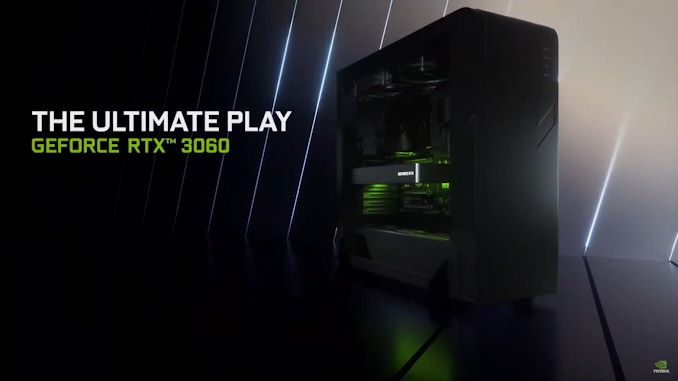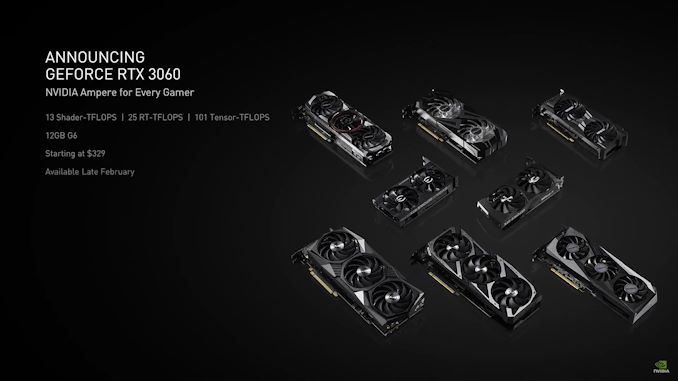NVIDIA’s GeForce RTX 3060 Gets a Release Date: February 25th
by Ryan Smith on February 12, 2021 12:30 PM EST- Posted in
- GPUs
- NVIDIA
- GeForce RTX
- Ampere
- RTX 3060

NVIDIA this morning has sent over a quick note revealing the release date for their next GeForce desktop video card, the RTX 3060. The mainstream(ish) video card, previously revealed at CES 2021 with a late February release date, has now been locked in for a launch on February 25th, with prices starting at $329.
As a quick recap, the RTX 3060 is the next card down in NVIDIA’s Ampere architecture consumer video card stack. Using the new GA106 GPU – which is already shipping in RTX 3060 laptops – the RTX 3060 follows the traditional price/performance cadence for video card launches, with NVIDIA releasing a cheaper and lower performing video card for the mainstream-enthusiast video card market. NVIDIA’s 60-tier cards have long been the company’s workhorse parts for 1080p gaming – as well as some of their highest-volume parts in North America – and the RTX 3060 is expected to fill the same role within the Ampere/30-series family.
| NVIDIA GeForce Specification Comparison | ||||||
| RTX 3060 | RTX 3060 Ti | RTX 2060 | GTX 1060 | |||
| CUDA Cores | 3584 | 4864 | 1920 | 1280 | ||
| ROPs | 64? | 80 | 48 | 48 | ||
| Boost Clock | 1.78GHz | 1.665GHz | 1.68GHz | 1.709GHz | ||
| Memory Clock | 14Gbps? GDDR6 | 14Gbps GDDR6 | 14Gbps GDDR6 | 8Gbps GDDR5 | ||
| Memory Bus Width | 192-bit | 256-bit | 192-bit | 192-bit | ||
| VRAM | 12GB | 8GB | 6GB | 6GB | ||
| Single Precision Perf. | 12.8 TFLOPS | 16.2 TFLOPS | 6.5 TFLOPS | 4.4 TFLOPS | ||
| Tensor Perf. (FP16) | 51.2 TFLOPS | 64.8 TFLOPS | 51.6 TFLOPS | N/A | ||
| Tensor Perf. (FP16-Sparse) | 102.4 TFLOPS | 129.6 TFLOPS | 51.6 TFLOPS | N/A | ||
| TDP | 170W | 200W | 160W | 120W | ||
| GPU | GA106 | GA104 | TU106 | GP106 | ||
| Transistor Count | ?B | 17.4B | 10.8B | 4.4B | ||
| Architecture | Ampere | Ampere | Turing | Pascal | ||
| Manufacturing Process | Samsung 8nm? | Samsung 8nm | TSMC 12nm "FFN" | TSMC 16nm | ||
| Launch Date | 02/25/2021 | 12/02/2020 | 01/15/2019 | 07/19/2016 | ||
| Launch Price | MSRP: $329 | MSRP: $399 | MSRP: $349 | MSRP: $249 Founders $299 |
||
NVIDIA has already published most of the specifications for the card back in January. Including the fact that it offers 28 SMs (3584 CUDA cores), and 12GB of GDDR6 running on a 192-bit memory bus. As with previous 60-tier cards, the non-power-of-two memory bus means that NVIDIA is shipping with a somewhat odd amount of memory, in this case 12GB, which is actually more than what comes on even the RTX 3080. However with the only other option being an anemic-for-2021 6GB, NVIDIA is opting to make sure that the card isn’t for want of VRAM capacity.
Meanwhile, for better or worse the RTX 3060 is all-but-guaranteed to fly off of shelves quickly. With every video card more powerful than a GTX 1050 Ti seemingly getting shanghaied into mining Ethereum, desperate gamers will be fighting with hungry miners for supplies. Even with the 192-bit memory bus, I would be shocked if the RTX 3060 wasn’t profitable, especially with Ethereum reaching record highs. So for anyone thinking of grabbing the card, best be prepared to camp out at your favorite retailer or e-tailer on that Thursday morning.
On a final note, unlike the other RTX 30 series cards launched to date, NVIDIA will not be producing any Founders Edition cards for the RTX 3060 series. So all of the cards released will be AIB cards with their own respective designs. And, if tradition holds, don't be surprised if we see the AIBs outfit their cards with premium features and raise their prices accordingly.











73 Comments
View All Comments
commenter001 - Friday, February 12, 2021 - link
annnnnnnnd it's sold outAchaios - Friday, February 12, 2021 - link
Out Of Stock.bigboxes - Tuesday, February 23, 2021 - link
annnnnnnnd it's selling for twice it's MSRP!raywin - Friday, February 12, 2021 - link
is this another Fictional Edition, or are they going to make enough to meet demand? Not that I am bitter...Yojimbo - Saturday, February 13, 2021 - link
This is one of those rare cases where the answer to a "this or that" question is 'no'. No, it's not a Fictional Edition. No, they won't make enough to meet demand.Spunjji - Monday, February 15, 2021 - link
This one's hardly worth the money for gamers anyway. They're really pushing their creative lie about "doubling" CUDA cores and FP32 FLOPS to cover for the fact that this will have very little advantage over the preceding generation in games, because it can't render at resolutions high enough to benefit substantially from that dynamic reassignment of INT32 resources to FP32. I'll be surprised if this substantially outperforms the 2060 Super at 1080p.In four generations, Nvidia have gone from having their third-rank card be a price/performance bargain as was traditional (GTX 970), to having their succeeding fourth-rank card be *substantially* more powerful than that for less money (GTX 1060), to charging third-rank video card prices for their fifth-rank card and for meagre performance increases. I'm not going to reward that with a purchase.
Yojimbo - Tuesday, February 16, 2021 - link
There's no lie, there's just an architecture change, and it wasn't done for marketing purposes. Enthusiasts look at games benchmarks to see how fast a card is, not the number of CUDA cores. And non-enthusiasts are not going to look at CUDA core counts, either. I imagine they look at the product number (3060 vs 3070). Of course it's foing to substantially outperform the 2060 SUPER.Firstly, with the 970 you are referencing a nadir in pricing. You are also referencing a card that had 3.5 GB of fast memory and .5 GB of slower memory to cut costs. But, that being said, GPU average selling prices, in terms of what customers are looking to pay, have been steadily climbing over the past 20 years. NVIDIA's rejiggering of their numbering schemes with respect to die sizes simply reflects that evolution of the market. You should probably buy the card that suits your value proposition. "Not rewarding" a company going about its business is an irrational thing. The prices that are charges are the prices of the market. NVIDIA doesn't set them. And if NVIDIA really were charging "third-rank video card prices for their fifth-rank card" their gross margins would be colossal now compared to back then, and that just isn't the case. The margins are pretty much the same as they were back then. It's the naming scheme that has changed, not the price being charged for the underlying hardware. In other words, a 3060 is a lot more expensive to make than a 960 or 1060. These are facts. You might not like the facts but there they are. Otherwise NVIDIA's gaming gross margins would be absolutely skyrocketing, and they are not.
brucethemoose - Friday, February 12, 2021 - link
Parts of the (non-cryptocurrency) compute crowd will be willing to shell out for this card too. 12GB of VRAM for under $500 is a bargain, especially with RTX/tensor cores and a nice transcoding block.sonny73n - Friday, February 12, 2021 - link
Midrange cards over $300? Whatever, shill.Qasar - Saturday, February 13, 2021 - link
um IF you actually read the article, then you would of seen the rtx 3060 launch price of $329, and the TI at 399, who's the shill ?